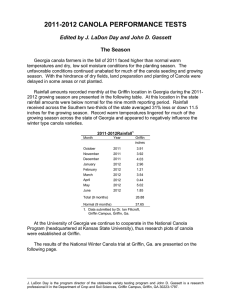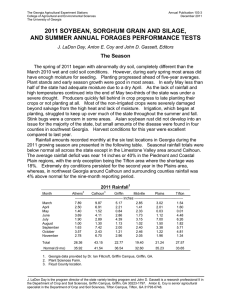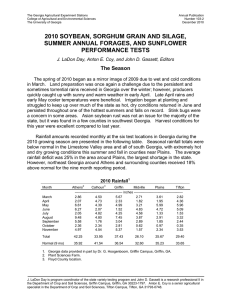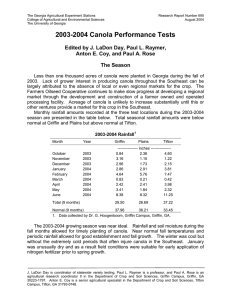--- Cf[
advertisement
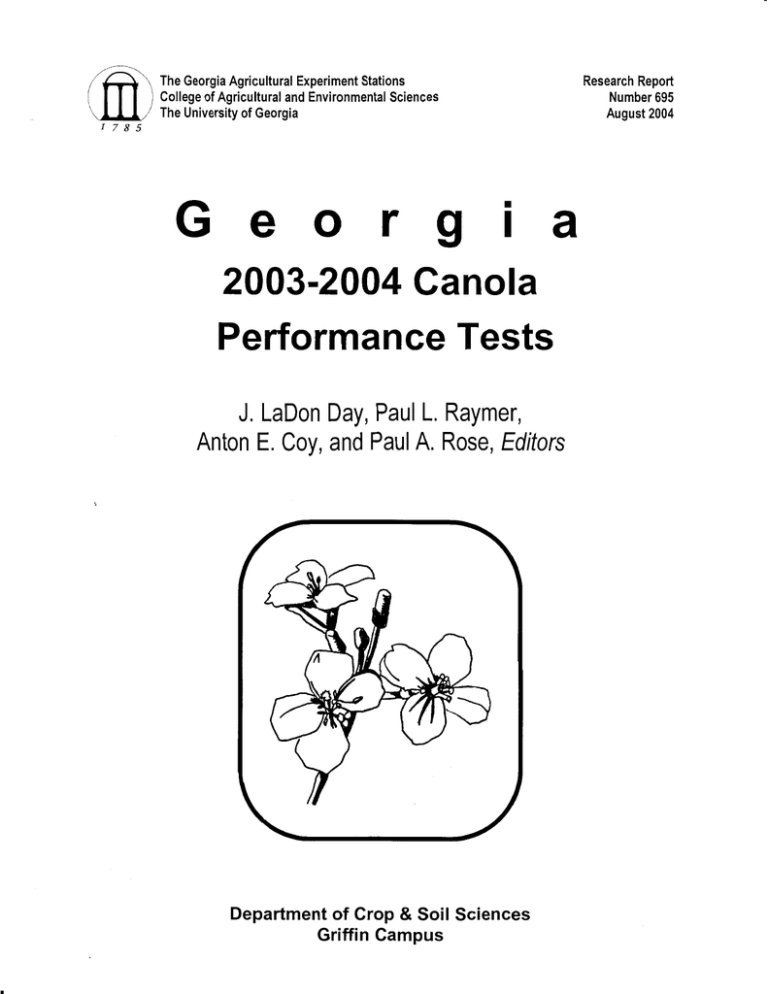
-Cf[ --~\ The Georgia Agricultural Experiment Stations ) College of Agricultural and Environmental Sciences I The University of Georgia 1 I Research Report Number 695 August 2004 7 8 5 G e 0 r g • I a 2003-2004 Canola Performance Tests J. LaDon Day, Paul L. Raymer, Anton E. Coy, and Paul A. Rose, Editors Department of Crop & Soil Sciences Griffin Campus The Georgia Agricultural Experiment Stations College of Agricultural and Environmental Sciences The University of Georgia Research Report Number 695 August 2004 Preface The term canola refers to varieties of rapeseed (Brassica napus L.) that produce high quality, edible oils with less than 2% erucic acid and defatted seed meals with less that 30 micromoles of aliphatic glucosinolates/gram. Canola seeds contain about 40 percent oil by weight. The oil is used primarily as a salad or cooking oil and in processed foods. Canola oil contains less than half the saturated fat of any other vegetable oil, has a favorable mix of mono- and polyunsaturated fats, and like other vegetable oils contains no cholesterol. The seed meal produced after oil extraction is approximately 35 percent protein and is used as feed for poultry or livestock. In 1985, the U.S. Food and Drug Administration changed its regulations to allow the use of low erucic acid rapeseed oil (canola oil) for human consumption in the U.S. The U.S. food industry quickly recognized the nutritional benefits of canola oil and began to market canola oil as a cooking oil and to utilize it in a growing number of processed foods. Rapid and widespread acceptance of canola oil by health-conscious American consumers has dramatically increased the demand for domestically grown canola. Domestic production of canola, however, has not been able to kept pace with this escalating consumer-driven demand. Georgia farmers are in an excellent position to profit by supplying these expanding markets. Mild winters, adequate winter rainfall, the potential to double-crop, and the availability of local oilseed processing facilities make the southeastern U.S. a promising site for canola production. Research conducted at the University of Georgia indicates that canola can be grown successfully in this region as a fall-planted winter annual. Machinery required and production costs for canola are similar to those for wheat and profit potential is equal or better than that of wheat. Variety evaluation trial results are reported from three locations in 2003-2004. Locations were Tifton in the Lower Coastal Plain region, Plains in the Upper Coastal Plain region, and Griffin in the Piedmont region. For identification of the trial locations, see the map below. Yields are reported in pounds per acre at 8.5% moisture. Yields may be converted to bushels per acre by dividing by 50 (50 lb/bu). Additional data such as oil content, beginning bloom date, maturity date, plant height, lodging, seed shatter, winter survival, and disease incidence are included when available. Information on cultural practices is presented in footnotes. The least significant difference (LSD) at the ten percent level has been included in the tables to aid in comparing entries within trials. If the yields of any two entries differ by the LSD value or more, they may be considered different. Bolding is used in the performance tables to indicate entries with yields statistically equal to the highest yielding entry in the test. The standard error (Std. Err.) of an entry mean is included and provides a general indicator of the level of precision of each experiment. The lower the value of the standard error of the entry mean, the more precise the experiment. This report is one of five publications presenting the performance of agronomic crops in Georgia. For information concerning other crops, refer to one of the following research reports: 2003 Corn Performance Tests (Research Report 690), 2003 Soybean, Sorghum Grain and Silage, Grain Millet, and Summer Annual Forages Performance Tests (Research Report 691), 2003 Peanut, Cotton and Tobacco Performance Tests (Research Report 692), and 2003-2004 Small Grain Performance Tests (Research Report 694). This report, along with performance test information on other crops, is also available at our web site www.griffin.uga.edu/swvt. Additional information may be obtained by writing to Mr. J. LaDon Day or Dr. Paul L. Raymer, Department of Crop and Soil Sciences, Griffin Campus, 1109 Experiment Street, Griffin, GA 30223-1797. The Georgia Agricultural Experiment Stations College of Agricultural and Environmental Sciences The University of Georgia Research Report Number 695 August 2004 Cooperators Dr. G. Hoogenboom, Biological and Agricultural Engineering Department, Griffin Campus, Griffin, Georgia. Mr. S. R. Jones, Southwest Research & Education Center, Plains, Georgia. Mr. H. G. Kendrick, Coastal Plain Experiment Station, Tifton, Georgia. Dr. D. V. Phillips, Plant Pathology Department, Griffin Campus, Griffin, Georgia. Mr. R. R. Pines, Southwest Research & Education Center, Plains, Georgia. Mr. J. C. Quick, Griffin Campus, Griffin, Georgia. Mr. T. E. Ross, Coastal Plain Experiment Station, Tifton, Georgia. Contributors The following individuals contributed to the gathering of data and the preparation of this report: W. Austin, C. Bennett, M. Brinkman, R. Brooke, R. Burton, S. Comer, R. Cooley, W. English, M. Flynn, M. Gilmer, D. Gresham, J. Penn, M. Pippin, D. Spradlin, W. Tucker, A. Wright, and D. Wyatt.
